White noise: Silence of the Swedish Lappland
Sweden's Norrbotten county is nothing if not a land of contrasts


The snowflakes swirl and swish gently in the breeze before they join the blanket of white that covers everything as far as the eye can see. It’s almost as if words from a Robert Frost poem have manifested themselves into the view from my hotel room window, 100 km south of the Polar Circle. It surprises me that the harsh reality of minus 35 degree Celsius can look so stark and beautiful all at once. But as I was to conclude after my three-month sojourn in Arvidsjaur, that little town in Sweden’s Norrbotten county was nothing if not a land of contrasts.
The first indication of this was evident even as the flight to Arvidsjaur began its descent and an endless stretch of white came into view. Not just snow-covered land, but also lakes frozen solid, giving the illusion that the town was a lot bigger than it actually was. My first close encounter with those hallowed lakes involved me shuffling my feet through the snow, imagining there really was solid earth underneath it all. Until I came to a patch where the snow had been cleared away. I could see little cracks on the surface. The ice had a disconcerting translucence to it. And then it did something that I later found out was quite commonplace up in Norrbotten and the Lappland region—it shifted and settled with an audible sigh. My companion looked at my shocked face and laughed. “Don’t worry about the noise, the ice is thick enough to land a small plane on,” he said. I shivered, half out of fright and half because of the cold, and continued trudging along. Fifteen steps later, I’d managed to slip and land on my behind, eliciting more laughter from my companion. Lappland clearly wasn’t for the faint of heart. But, looking at the frost-covered trees around me, and that beautiful white ice, I realised it was already beginning to grow on me.
Arvidsjaur, on the icy road 860-odd kilometres north of Stockholm, is a tiny town. If you’re in a hurry, you’ll drive right through it and barely realise it’s gone by. So tiny that the population of approximately 4,500 people has at some point or the other come into contact with one another, and if they don’t know each other, they know of each other. In fact, one young lady complains that privacy is almost non-existent. Another tells me there’s nothing to do on her days off and there’s nowhere to go. Having lived all my life in cities, I find myself concurring with her. I wonder whether agreeing to accompany my husband there on a three-month work trip was a good idea.
After all, just a month later, I find the quiet too quiet, the calm too calm, and the constant peace disconcerting. But for many residents, the extreme stillness is precisely the best thing about the town. The fact that they all know each other means there’s next to no crime. And when some nefarious activity does take place, it’s so uncommon that shock grips the entire town. After all, this is a place where most people don’t bother locking their front doors and leave the keys in their unlocked cars. It’s a town that has a police force comprising two people, and the most work the officers have is at the Saturday night discotheque from where they might have to occasionally escort slightly inebriated Svens or Larses home.
In fact, the most trouble you can get into is if you hit a reindeer with your car and don’t report it. Not surprising, as the reindeer forms the backbone of the economy, especially for the indigenous Sami people. And to truly know what the reindeer means to the Lappland, you need to visit a reindeer farm.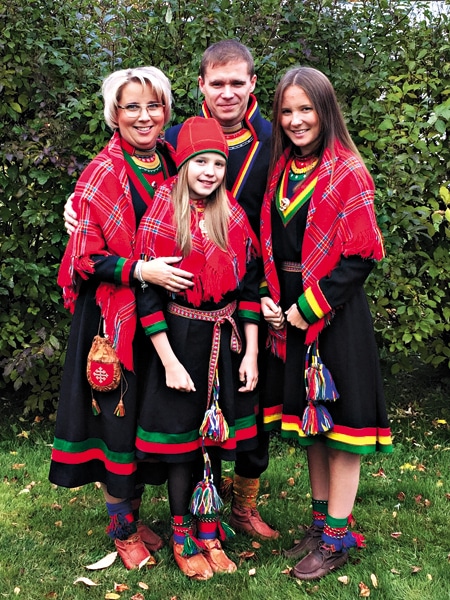 The Granbergs believe reindeer herding is best when it is a family activity. Here they are seen in traditional Sami garb called the Gákti
The Granbergs believe reindeer herding is best when it is a family activity. Here they are seen in traditional Sami garb called the Gákti
Image: Vaishali Dinakaran
I’m fortunate enough to be put in touch with Jennie and Olov Granberg, who belong to the Sami community and are still actively involved in reindeer farming. Early one freezing morning, I find myself on the back of a snowmobile, clinging on for dear life, as Jennie deftly navigates mounds of snow, taking me from one feeding site to the next. No sooner have we thrown down reindeer pellets than there’s a tinkling of bells and the sound of hooves. Instead of the two or three reindeer that I was expecting, we’re surrounded by a massive herd of the pale brown pelted animals. Jennie shows me how the reindeer are branded to differentiate who they belong to. I’ve been forewarned that it is exceptionally bad manners to ask someone how many reindeer they own, so I refrain. But Jennie explains that anyone can own a reindeer, even me, but it’s the farming and the herding of the “ren” that is left entirely to the Samis, primarily to safeguard the livelihood of the community.
When I spot one reindeer eyeing me suspiciously, I back away and allow Jennie’s brave three-year-old granddaughter to toss it some moss. Jennie’s youngest daughter is with us, also riding a snowmobile rather expertly. Olov is chasing a sick reindeer into a pen because it’s meant to be kept away from the rest of the herd. “If we don’t do this together, we won’t see each other at all,” Jennie says. “It’s the best way for the family to spend time together, and for the next generation to learn how it must be done.” Olov, born and raised in Arvidsjaur, tells me that he never considered doing anything else with his life. “It’s a part of us,” his wife says, explaining the link the Sami people have to the reindeer.
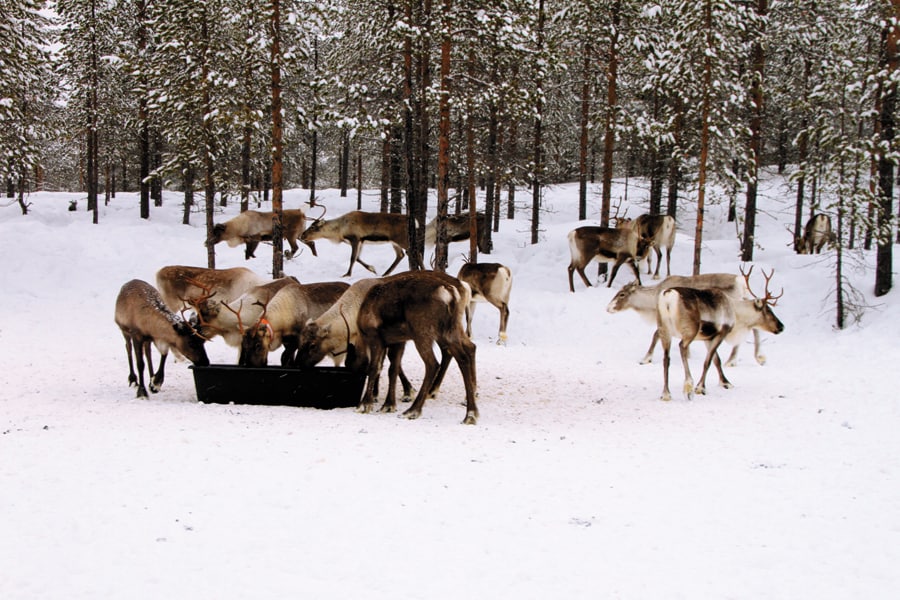
No sooner are the pellets thrown down at a reindeer farm than you’re surrounded by the hungry herd. Their farming and tending is left to the Sami people
Image: Vaishali Dinakaran
There’s more to Arvidsjaur than just the reindeer though, and I spend my time in the icy town exploring. I visit the local antique store. I go on walks, tramping over the frozen lakes when the opportunity arises. At the local supermarkets, I soon discover where to buy the best elk salami and frozen elk mince, and where the good rotisserie chicken is to be had. I down a few cups of coffee and a slice of cake at one of the two local cafes—Hans Pa Hornet—in an attempt to get into the habit of the Swedish coffee break or fika. I find that a local Greek restaurant, Afrodite, serves a mean reindeer plank. I discover that the fare at the second coffee shop, Tant Sveas, rivals big city cafes. I spend hours one day exploring every architectural facet of the local church. I visit the Hembygdsmuseum, the old Parish that has now been turned into a museum that gives you a glimpse into life in the early 1900s. I chat with Åsa, who runs Anna-Lisa’s souvenir boutique, who tells me how it’s important to preserve the artisanal industries of the region. I take great delight in the fact that Roland Sandgren, who mans the coat check booth at Rolle’s Krog, a local watering hole, also owns the place. He is also the bass guitarist for the accomplished band that belts out everything from Chuck Berry’s ‘Johnny B Goode’ to ZZ Top’s ‘Sharp Dressed Man’. Mostly I just watch people go by. And I realise that what I have perceived as quiet is, in fact, Arvidsjaur at its very busiest.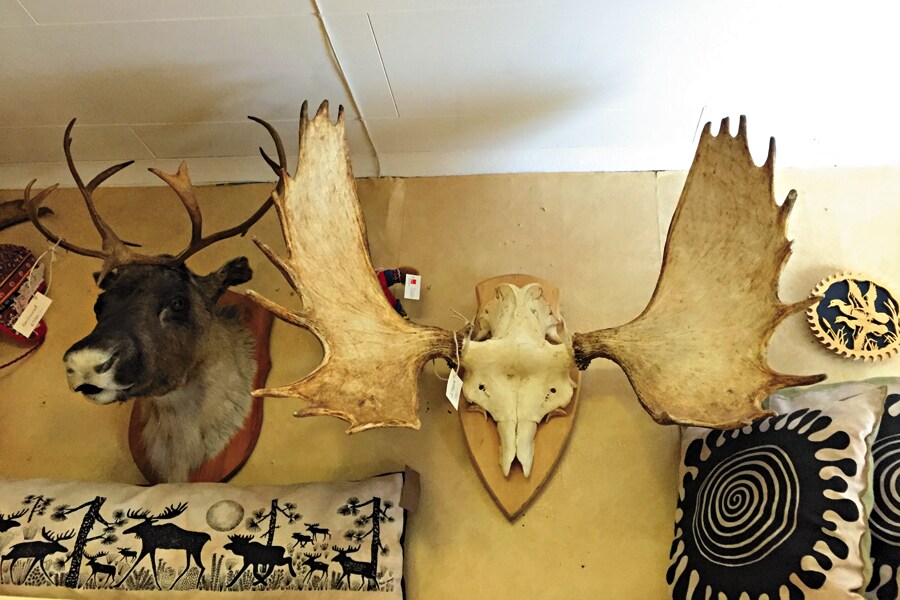 Moose memorabilia all through Sweden, mounted heads included
Moose memorabilia all through Sweden, mounted heads included
Image: Vaishali Dinakaran
During winter, Arvidsjaur goes international. The car test industry descends upon the town, because the cold winters are perfect for extreme weather testing. Every hotel is booked completely. Visitors fly in from all over the world with one aim—to get to drive on the ice tracks designed on the frozen lakes. Drift schools, driving experiences, development driving—it all happens right here, in addition to the more normal attractions of skiing, sleigh rides, and dogsled rides. And with the influx of people comes an influx of money, a shot in the arm for businesses that helps them survive all year round. It’s a good time for the locals. For people so used to seeing only familiar faces, there’s a certain appeal in seeing new people, making new friends, and for the young and unattached, maybe even striking up the odd dalliance.
By the end of my second month, I miss the trappings of the city less and less. I spend hours staring out of windows watching the dance of the snowflakes. I gaze at the sun setting over the frozen lake every evening, changing everything from white to gold. And I learn to keep an eye out for the mystical green Aurora Borealis that lights up the sky every now and again. I stop regretting the times I don’t have a camera. I savour the experiences instead. 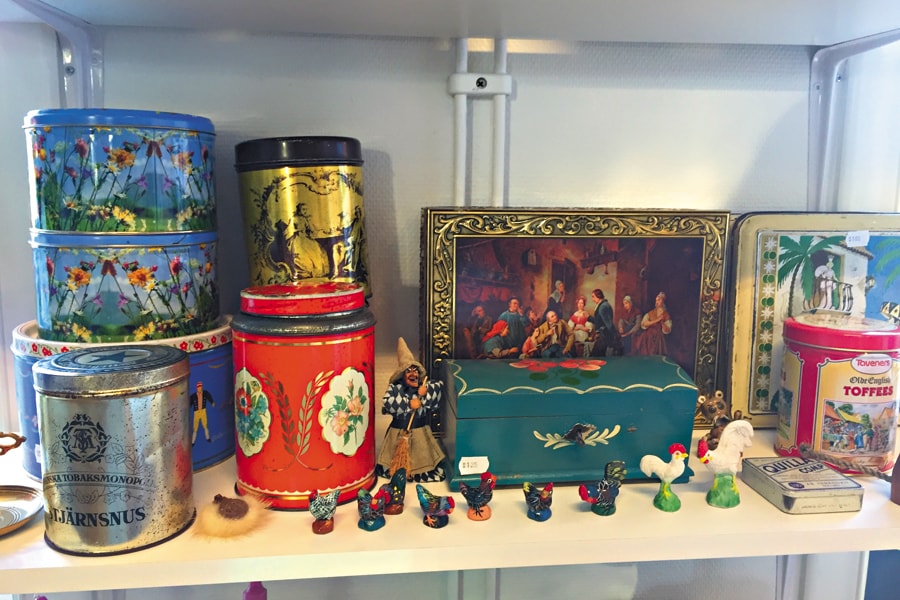 Arvidsjaur’s little antique store has knick-knacks aplenty
Arvidsjaur’s little antique store has knick-knacks aplenty
Image: Vaishali Dinakaran
To help me get an insight into how Arvidsjaur has evolved as a town, I am pointed in the direction of Lena Lindgren. Born and raised in Arvidsjaur, 67-year-old Lindgren has, over the course of her life, been a kindergarten teacher, a music teacher, a municipal administrator, a jewellery maker (post retirement), and, most importantly, a chronicler of Arvidsjaur’s history, having written several short books about the place. She’s a bundle of energy and rapidly takes me through the history of the town. She speaks of how in 1606, the King of Sweden sent envoys to inform the Sami people that their land was to be annexed into Sweden. Churches were built in Arvidsjaur and further up in the town of Jokkmokk, and a market was set up at the two places. Soon trade began, taxes were paid, people began to brave the cold to travel to and from the churches, and Sami settlements, like Arvidsjaur’s Lappstaden, were built for people to stay in along the way.
 Lena Lindgren poses with the books she’s written on Arvidsjaur’s history
Lena Lindgren poses with the books she’s written on Arvidsjaur’s history
Image: Vaishali Dinakaran
Lindgren then bundles me up into her little hatchback and zips me through the town, taking me to visit everything from the school to the military encampment nearby, to the house she grew up in. The most interesting visit we make, however, is to meet her parents. Her father, the multifaceted Folke Lindgren (who has been a teacher, an ornithologist of considerable repute and an accomplished artist), is four months shy of 98. Her mother, May, is two months shy of 100. The two have seen Arvidsjaur transition from a time when families lived off the land itself to a more modern era. But they’ve never felt isolated from the world, nor considered moving away. They travelled when they felt like it, driving from Arvidsjaur to Germany, France and Turkey in the summers. They saw the world. And they always came back to the Lappland. “Why would I want to leave my home?” May asks. Lena says, “It was always good to go out. But it was also always good to come back home.”At first I wonder if this longing for home is because they’re from a different generation. A lot of the young men and women I speak to seem to be listless about the quiet, especially once winter is over and the visitors leave. “What do people do here then?” I ask a bar manager at Hotell Laponia when I find out that the weekly disco and quite a few restaurants shut at the end of the season. “People walk... some of us work out a lot, spend a lot of time at the gym,” says the young lady whose time in the gym can be evidenced by the size of her muscles, in stark contrast to a perfectly made-up face. “Drinking is a hobby for a lot of people,” her voice trails off.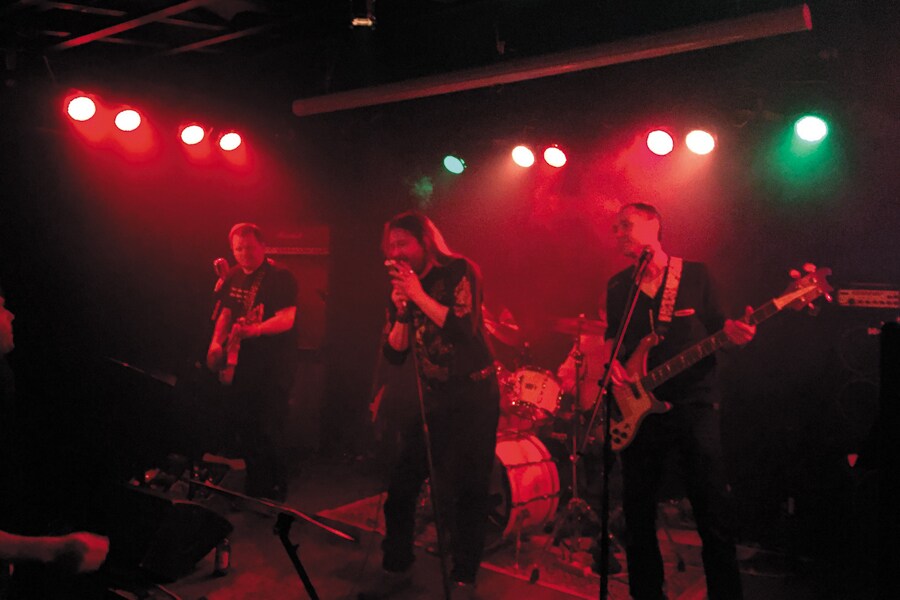 The house band Rock and Rolles plays at local watering hole Rolle’s Krog
The house band Rock and Rolles plays at local watering hole Rolle’s Krog
Image: Vaishali Dinakaran
But I discover there’s the other camp of young people too. Maja Gustavsson, who manages The Clarion Collection Hotel, tells me there’s always something to do and that she can’t imagine living in a city. “Here I can go for a stroll in the forest whenever I feel like it. And if I absolutely need city life, I can hop on a plane,” she says.
And, though the people might leave, the summer brings barbeques, hiking, swimming, fishing and the midnight sun too. Which gets me thinking that perhaps to truly know a place it isn’t enough to see it through the frosted glass panes of a single season.
On my very last night in Arvidsjaur, this feeling is reaffirmed. I’m at the season-ender party that Hotell Laponia hosts for its staff, to which a few lucky guests like myself, who have spent the better part of the winter there, find ourselves invited.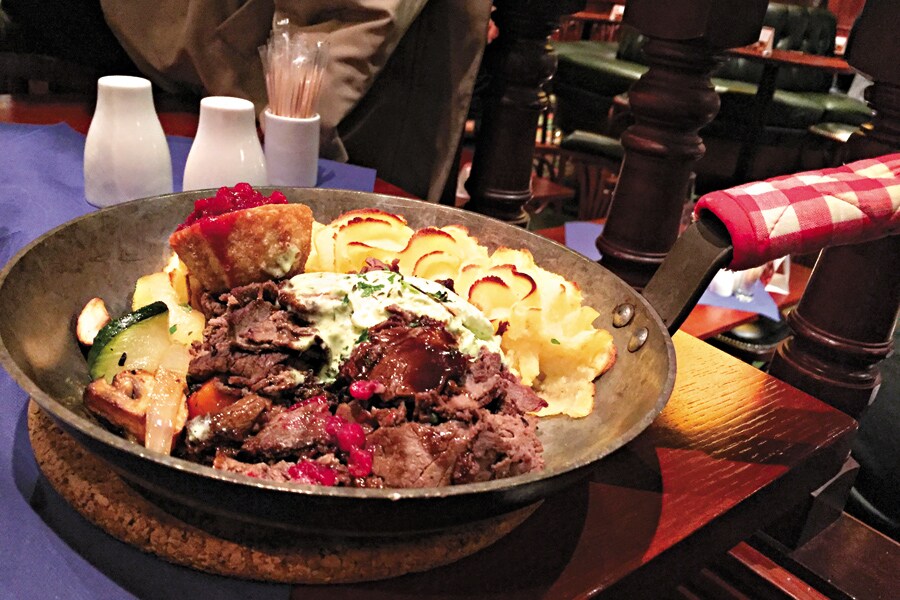 Jägarpanna — thinly sliced smoked elk meat served with pommes duchesse, herb creme and lingonberries
Jägarpanna — thinly sliced smoked elk meat served with pommes duchesse, herb creme and lingonberries
Image: Vaishali Dinakaran
There’s music, dancing, costumed revelry, laughter and plenty of alcohol. I force some strong licorice-flavoured brew down my throat (for it was offered me good-naturedly) as Kristofer Lundstrom, who owns the hotel, speaks of the onset of winter in Arvidsjaur. “For two weeks a year, when the lakes begin to freeze and form ice, it’s magical,” he says. “It makes a sound that’s musical, almost like an orchestra.”
We’ve chosen to drive back home to Berlin and as we start early morning, it begins to snow. An hour into our journey, we chance upon a little Tibetan temple in the middle of nowhere, with prayer flags fluttering around it. And Kristofer’s words about the lake orchestra come flooding back. It strikes me that I’ve only experienced the silence of the Lappland. I believe I’ll have to go back to hear its music.
First Published: Nov 05, 2016, 05:14
Subscribe Now(This story appears in the Dec 31, 2010 issue of Forbes India. To visit our Archives, Click here.)